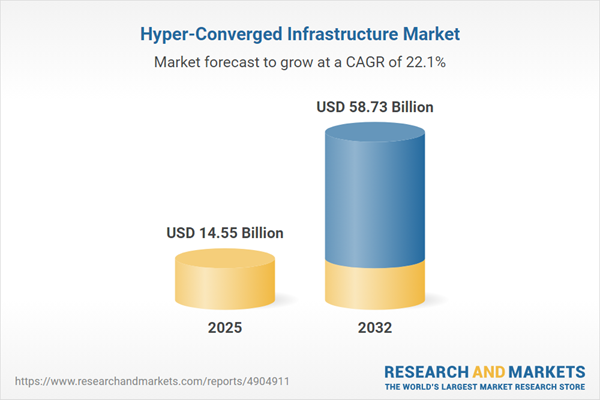Speak directly to the analyst to clarify any post sales queries you may have.
Hyper-converged infrastructure (HCI) is reshaping enterprise IT strategies by centralizing and simplifying management of compute, storage, and networking, helping organizations accelerate modernization while supporting digital initiatives with increased agility and reliability.
Market Snapshot: Hyper-Converged Infrastructure Market Size and Growth
The global hyper-converged infrastructure market reached USD 11.86 billion in revenue in 2024, highlighting robust expansion as enterprises look to streamline IT environments and centralize operational control. Growing adoption emerges from the demand for efficient, scalable infrastructure that sustains business continuity and digital transformation. Regions such as Asia-Pacific, including China, India, Singapore, and Taiwan, show marked acceleration in HCI deployment as organizations build resilient infrastructure. Financial services, healthcare, manufacturing, public sector, and retail are prominent verticals adopting HCI to manage compliance, maintain high system availability, and drive technological innovation, underscoring the expanded reach of hyper-converged solutions.
Scope & Segmentation: Hyper-Converged Infrastructure
- Component: Integrated hardware, software, and services simplify IT management, enabling organizations to operate both modern and legacy systems with unified oversight.
- Hardware: Scalable platforms that merge computing, storage, and networking deliver flexibility to support dynamic workloads and evolving business needs.
- Services: Consulting, deployment, integration, management, and technical support help businesses navigate complex rollouts and maintain operational stability regardless of size or risk.
- Software: Automation, virtualization, hypervisors, and orchestration tools provide adaptability for hybrid and multicloud deployment, supporting infrastructure transformation for a variety of environments.
- Deployment Mode: Cloud, on-premises, and hybrid models offer organizations the ability to address regulatory, security, and continuity goals based on operational demands.
- Organization Size: Modular HCI solutions are designed for all enterprise scales, from large organizations needing wide scalability to smaller businesses seeking flexibility and compliance support.
- End-User Industry: Adoption spans financial services, healthcare, public sector, IT and telecom, manufacturing, and retail, where secure data handling, efficiency, and uptime are pivotal.
- Regional Coverage: Americas, Europe, the Middle East, Africa, and Asia-Pacific demonstrate global uptake, with growing economies prioritizing rapid digitalization for competitive advantage.
- Key Companies: Dell Technologies, Nutanix, Hewlett Packard Enterprise, Cisco, VMware, Huawei, Lenovo, Microsoft, Scale Computing, and Pivot3 lead advancement with innovative platforms and service models.
Key Takeaways: Strategic Insights for Decision-Makers
- Unified HCI management simplifies operational processes and supports critical business workflows distributed across multiple locations and teams.
- Enhanced automation and improved visibility empower leaders to optimize IT resources, adapt to evolving technological requirements, and proactively manage systems.
- Cloud-enabled HCI enables secure, remote management while ensuring ongoing compliance with shifting regulatory and data security standards.
- Hybrid and multicloud deployment reduce IT complexity and support flexible organizational structures, especially for operations spanning different regions.
- Integrated compliance features in HCI solutions facilitate efficient response to new external regulations or internal policy changes.
- Balancing cloud and on-premises strategies helps organizations remain scalable and maintain robust data protection as business requirements change.
Tariff Impact: Adjusting Procurement and Supply Chain Strategies
Recent U.S. tariffs have prompted organizations to re-examine IT procurement and supply chain approaches. Enterprises are mitigating exposure by renewing supplier agreements, investigating nearshoring alternatives, and widening their vendor base to safeguard project continuity. These adjustments support risk management and supply stability as regulatory conditions evolve and impact technology sourcing and hardware availability.
Methodology & Data Sources
This hyper-converged infrastructure market report is developed through detailed technical analysis, direct engagement with senior IT executives, and a comprehensive review of regulatory developments. Insights are validated by benchmarking across industry peers and robust market data analysis, ensuring accuracy in tracking adoption trends and market progression.
Why This Report Matters
- Enables executive decision-making by aligning IT investment with organizational modernization and compliance priorities.
- Delivers pragmatic, risk-sensitive recommendations tailored to regional, sectoral, and regulatory demands for effective technology adoption.
- Prepares organizations for evolving compliance requirements and sector-specific technology needs through practical, actionable insights.
Conclusion
Strategic adoption of hyper-converged infrastructure equips organizations to respond rapidly to change, ensuring operational continuity and supporting transformative IT initiatives for sustained efficiency and resilience.
Additional Product Information:
- Purchase of this report includes 1 year online access with quarterly updates.
- This report can be updated on request. Please contact our Customer Experience team using the Ask a Question widget on our website.
Table of Contents
3. Executive Summary
4. Market Overview
7. Cumulative Impact of Artificial Intelligence 2025
Companies Mentioned
The companies profiled in this Hyper-Converged Infrastructure market report include:- Dell Technologies Inc.
- Nutanix, Inc.
- Hewlett Packard Enterprise Company
- Cisco Systems, Inc.
- VMware, Inc.
- Huawei Technologies Co., Ltd.
- Lenovo Group Ltd.
- Microsoft Corporation
- Scale Computing, Inc.
- Pivot3, Inc.
Table Information
| Report Attribute | Details |
|---|---|
| No. of Pages | 191 |
| Published | November 2025 |
| Forecast Period | 2025 - 2032 |
| Estimated Market Value ( USD | $ 14.55 Billion |
| Forecasted Market Value ( USD | $ 58.73 Billion |
| Compound Annual Growth Rate | 22.1% |
| Regions Covered | Global |
| No. of Companies Mentioned | 11 |









